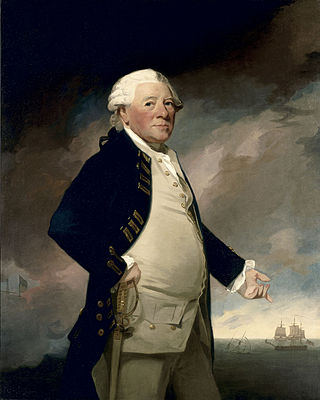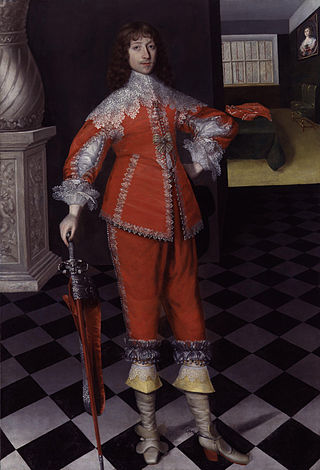Related Research Articles

John Hervey, 1st Earl of Bristol was an English Whig politician.

Earl of Lonsdale is a title that has been created twice in British history, firstly in the Peerage of Great Britain in 1784, and then in the Peerage of the United Kingdom in 1807, both times for members of the Lowther family.

Viscount Gage, of Castle Island in the County of Kerry of the Kingdom of Ireland, is a title in the Peerage of Ireland. It was created in 1720 for Thomas Gage, along with the subsidiary title of Baron Gage, of Castlebar in the County of Mayo, also in the Peerage of Ireland. In 1744 he also succeeded his cousin as eighth Baronet, of Firle Place. The titles remain united. The Gage family descends from John Gage, who was created a baronet, of Firle Place in the County of Sussex, in the Baronetage of England on 26 March 1622. His great-grandson, the seventh Baronet, represented Seaford in Parliament. He was succeeded by his first cousin, Thomas Gage, 1st Viscount Gage, the eighth Baronet. He sat as a Member of Parliament for Minehead and Tewkesbury and also served as Governor of Barbados. In 1720, 24 years before succeeding in the baronetcy, he was raised to the Peerage of Ireland as Baron Gage and Viscount Gage. His second son was the military commander the Hon. Thomas Gage.

John Lowther, 1st Viscount Lonsdale, PC FRS, known as Sir John Lowther, 2nd Baronet, from 1675 to 1696, was an English politician.
There have been eleven Gordon Baronetcies :

There have been seven baronetcies created for persons with the surname Parker, three in the Baronetage of England, two in the Baronetage of Great Britain and two in the Baronetage of the United Kingdom. Two of the creations are extant as of 2008. Though none of the different families of baronets were related, several supplied a number of flag officers to the Royal Navy.
There have been nine baronetcies created for persons with the surname Moore, two in the Baronetage of England, one in the Baronetage of Ireland, two in the Baronetage of Great Britain and four in the Baronetage of the United Kingdom. As of 2014 two creations are extant and one is considered dormant.

The Gibson, later Gibson-Carmichael, later Gibson-Craig-Carmichael Baronetcy, of Keirhill in the County of Edinburgh, is a title in the Baronetage of Nova Scotia. It was created on 31 December 1702 for Thomas Gibson, with remainder to his heirs male. The sixth Baronet assumed the additional surname of Carmichael. The eleventh Baronet was a Liberal politician. In 1912, he created Baron Carmichael, of Skirling in the County of Peebles, in the Peerage of the United Kingdom. The barony died in 1926, while he was succeeded in the baronetcy by his kinsman Sir Henry Thomas Gibson-Craig-Carmichael, 5th Baronet, of Riccarton, who became the twelfth Baronet of Keirhill and assumed the additional surname of Carmichael.
There have been five baronetcies created for persons with the surname Reid, one in the Baronetage of Nova Scotia and four in the Baronetage of the United Kingdom. As of 2019 one creation is extant.

Baron Belasyse was a title that was created twice in the Peerage of England. The first creation came on 27 January 1645 when the Honourable John Belasyse was made Baron Belasyse of Worlaby in the County of Lincoln. He was the second son of Thomas Belasyse, 1st Viscount Fauconberg, the younger brother of the Honourable Henry Belasyse and the uncle of Thomas Belasyse, 1st Earl Fauconberg. He was succeeded by his grandson, Henry, the second Baron, the son of Sir Henry Belasyse, who was killed in a duel in 1667. The title became extinct when the second Baron died childless in 1691.
There have been three baronetcies created for persons with the surname Osborne, two in the baronetage of England and one in the baronetage of Ireland. Two creations are extant.

The Dixie Baronetcy was created in the Baronetage of England at the time of the Restoration of the Monarchy in 1660 for Sir Wolstan Dixie (1602–1682), a supporter of King Charles I during the English Civil War and afterwards. He was descended from a brother of Sir Wolstan Dixie, the sixteenth century Lord Mayor of London who founded the Dixie Professorship of Ecclesiastical History in the University of Cambridge. Their home was Bosworth Hall near Market Bosworth in Leicestershire. The title became extinct with the death of the thirteenth Baronet, another Sir Wolstan Dixie, in 1975.
The Sinclair Baronetcy of Stevenson in the County of Haddington, is a title in the Baronetage of Nova Scotia. It was created on 18 June 1636 for John Sinclair of Stevenson, with remainder to his heirs male whatsoever. The third Baronet was a Baron of the Exchequer and member of the Privy Council of Scotland. The fourth Baronet married Martha, daughter and eventual heiress of Sir John Lockhart of Castlehill, a Lord of Session under the judicial title of Lord Castlehill. The eighth Baronet was an Admiral in the Royal Navy. On the death in 1899 of his son, the ninth Baronet, the title passed to a descendant of James Sinclair, younger son of the fifth Baronet, who in 1764 had inherited the Lockhart estates and assumed the surname of Lockhart. The tenth Baronet was a major general in the British Army and assumed the additional surname of Lockhart. The eleventh Baronet was the son of George Duncan Lockhart, another descendant of James, younger son of the fifth Baronet.
The Bland Baronetcy, of Kippax Park in the County of York, was a title in the Baronetage of England. It was created on 30 August 1642 for Thomas Bland, of Kippax Park, near Leeds, Yorkshire, in honour of his father's service to King Charles I. The third Baronet succeeded his father as an infant, died at the age of five and was succeeded by his brother who was Member of Parliament for Appleby 1681 and for Pontefract 1698–1713. The fifth Baronet represented Lancashire 1713–27 and the sixth Baronet served as member for Ludgershall 1754–5. His brother succeeded in 1755 but died in 1756, at which time the baronetcy became extinct.

The Fettiplace Baronetcy, of Childrey in the County of Berkshire, was a title in the Baronetage of England. It was created on 30 March 1661 for John Fettiplace as a reward for the support given by members of the family, particularly John's uncles John and Edmund, to the Royalist cause in the English Civil War. The title became extinct on the death of the fifth Baronet in 1743.
The Cropley Baronetcy, of Clerkenwell in the County of Middlesex, was a title in the Baronetage of England. It was created on 7 May 1661 for John Cropley. The second Baronet sat as Member of Parliament for Shaftesbury. The title became extinct on his death in 1713.
Three Steuart baronetcies were given to three brothers, the first, fourth, and seventh of the seven sons of Sir James Steuart, knight, Lord Provost of Edinburgh, who died in 1681.

Sir Edmund Prideaux, 4th Baronet (1647–1720), of Netherton, Farway was a British lawyer and politician who sat in the House of Commons from 1713 to 1720.
Sir Cyril Wyche, 1st Baronet was an English diplomat who served as Envoy Extraordinary to Hamburg Envoy Extraordinary and Minister Plenipotentiary to Russia.